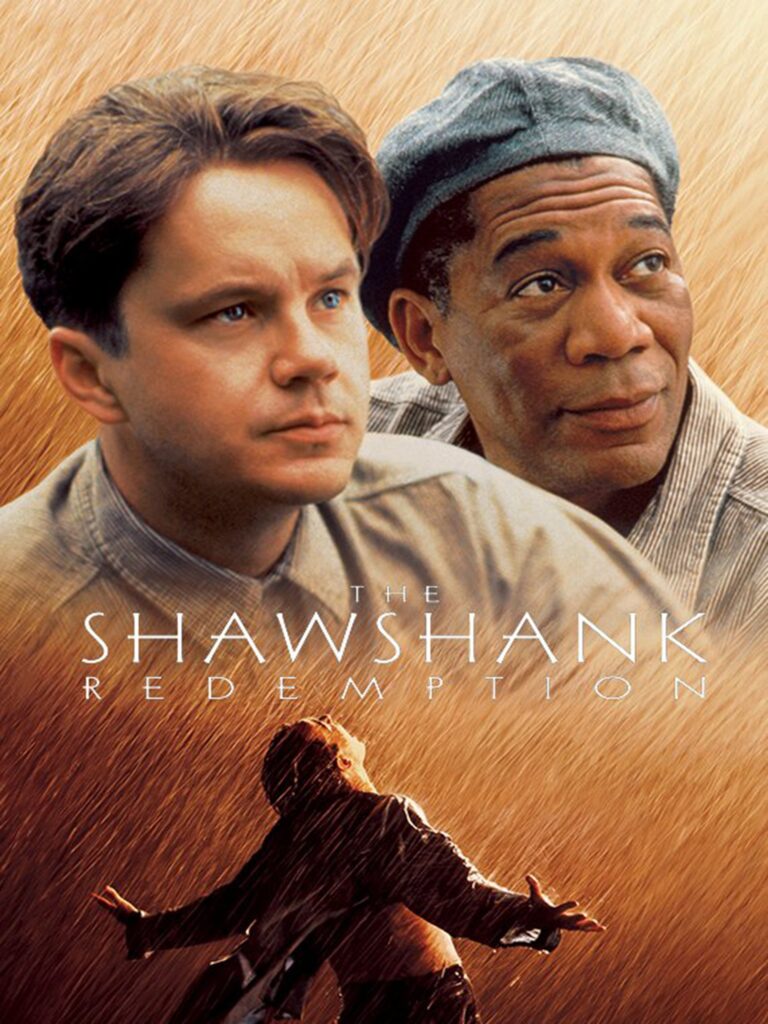
The Shawshank Redemption (1994) – A Timeless Tale of Hope
Frank Darabont’s The Shawshank Redemption (1994) is one of the most beloved films of all time. Based on Stephen King’s novella Rita Hayworth and Shawshank Redemption, the film explores themes of hope, friendship, and the resilience of the human spirit. Despite its initial lukewarm box office reception, it gained immense popularity through word-of-mouth and critical acclaim, eventually earning its place as a classic.
Plot Summary

Credit: IMDb
The film follows the story of Andy Dufresne (Tim Robbins), a banker wrongly convicted of murdering his wife and her lover. Sentenced to two consecutive life terms at Shawshank Prison, Andy quickly realizes the brutality of prison life, where corruption and violence are commonplace. He befriends Ellis “Red” Redding (Morgan Freeman), a long-time inmate known for smuggling contraband.
Andy earns the respect of both prisoners and guards through his intelligence and financial expertise, helping Warden Norton (Bob Gunton) launder money under a false identity, “Randall Stephens.” Over the years, he endures numerous hardships, including solitary confinement and abuse from prison gangs. However, Andy never loses hope.
The film’s turning point comes when Andy discovers evidence proving his innocence but is denied justice by the corrupt warden. Realizing that he will never be freed legally, Andy meticulously executes a daring escape by tunneling through his cell wall over 19 years. He crawls through a sewage pipe and emerges as a free man, exposing the warden’s corruption along the way. The film ends on a hopeful note as Red, after serving 40 years, is finally granted parole and reunites with Andy in Zihuatanejo, Mexico.
Themes and Symbolism

Credit: IMDb
-
Hope vs. Despair
The film’s most significant theme is hope, embodied in Andy’s unwavering belief in freedom. While other inmates accept their fate, Andy refuses to let prison define him. His famous line, “Hope is a good thing, maybe the best of things, and no good thing ever dies,” serves as the film’s core message. -
Friendship and Redemption
The deep bond between Andy and Red is central to the story. Their friendship transcends the bleakness of prison life, proving that even in the darkest places, human connection can thrive. Red, initially cynical, learns the value of hope through Andy, leading to his own redemption. -
Institutionalization and Freedom
The film explores the idea of institutionalization, where long-term inmates struggle to adapt to the outside world. Brooks (James Whitmore), an elderly prisoner, tragically ends his life after being unable to cope with freedom. In contrast, Red breaks free from this cycle by choosing hope. -
Corruption and Justice
Warden Norton and Captain Hadley (Clancy Brown) represent the corruption within the prison system, abusing power for personal gain. Andy’s meticulous plan to expose them is a satisfying moment of justice.
Performances and Direction
https://youtu.be/PLl99DlL6b4?si=RYxcIYotPhOa8JNA
Morgan Freeman’s portrayal of Red is widely regarded as one of the finest performances in cinema. His warm yet world-weary narration adds depth to the story, making him the perfect guide through Shawshank’s walls. Tim Robbins delivers a subtle yet powerful performance as Andy, portraying quiet resilience and intelligence.
Frank Darabont’s direction brings Stephen King’s story to life with poignant storytelling, stunning cinematography, and an emotionally stirring score by Thomas Newman.
Legacy and Impact
Despite receiving seven Academy Award nominations, The Shawshank Redemption did not win any Oscars, overshadowed by Forrest Gump (1994). However, it gained cult status through home video and television broadcasts, eventually topping IMDb’s list of greatest films.
Conclusion
The Shawshank Redemption is more than just a prison drama—it’s a profound meditation on hope, resilience, and the human spirit. Its message remains timeless, reminding us that even in the darkest moments, hope can set us free.




